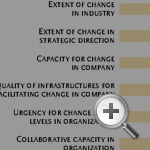The Dynamic Synchronization of Strategy and Information Technology
Managers are continually being confronted with new and ever-changing competitive pressures from deregulation, globalization, ubiquitous connectivity and the convergence of industries and technologies. But managers’ ability to respond rapidly to those challenges is predicated upon having a sophisticated and facile organizational and technical infrastructure, and a degree of information-technology flexibility that traditional approaches cannot provide. Increasingly, even at global companies known for their competitive and technical savvy, the gap between emerging strategic direction and IT’s ability to support it is significant and debilitating.
Working with more than 500 senior executives in large companies over the past four years, we have been able to identify the nature and seriousness of this disconnection. Typically, we worked with groups of 25 to 30 managers, each focused on business transformation. We asked managers to respond to a set of questions about their capacity to lead change within their companies. Almost invariably, they indicated that the quality of the IT infrastructures in their organizations lagged behind their need and desire for change and was, to some degree, an impediment to it. (See “Managers’ Dim View of Companies’ Capacity To Lead Industry Change.”)
Although in every case, the companies’ chief information officers or chief technology officers sincerely intended to support the business managers in creating value in quickly evolving markets, they were constrained by legacy infrastructure —incompatible databases and applications, poor quality of data, restricted scalability and business processes trapped in vendors’ software modules. Moreover, because IT departments are often assessed on their ability to control costs and not on their ability to respond flexibly to strategy, the expectations and goals of the business managers were, in many cases, at odds with those of the CIOs and CTOs.
The required flexibility — IT or strategic — will not be created without a shared understanding and a shared agenda between the business managers and IT managers. In this paper, we will develop an approach to reconcile that disconnection — an application scorecard to facilitate dialogue within corporations and enable business managers and IT managers to close the gap.
References
1. C.K. Prahalad and V. Ramaswamy, “The Co-Creation Connection,” Strategy + Business (spring 2002): 50–61.
2. C.K. Prahalad and V. Ramaswamy, “The Collaboration Continuum,” Optimize, November 2001, www.optimizemag.com/issue/001/ strategies.htm; C.K. Prahalad and V. Ramaswamy, “Co-Opting Customer Competence,” Harvard Business Review 78 (January–February 2000): 79–87; and T.H. Davenport, J.G. Harris and A.K. Kohli, “How Do They Know Their Customers So Well?” MIT Sloan Management Review 42 (winter 2001): 63–73.
3. C.K. Prahalad and M.S. Krishnan, “New Meaning of Quality,” Harvard Business Review 77 (September–October 1999): 109–118.
4. D. Severance and J. Passino, “Making IT Work: Executive Guide To Implementing IT Systems” (Ann Arbor, Michigan: University of Michigan Business School, in press).
5. M. Broadbent and P. Weill, “Management by Maxim: How Business and IT Managers Can Create IT Infrastructures,” Sloan Management Review 38 (spring 1997): 77–91.
6. J.W. Ross and C.M. Beath, “Beyond the Business Case: New Approaches to IT Investment,” MIT Sloan Management Review 43 (winter 2002): 51–59.


